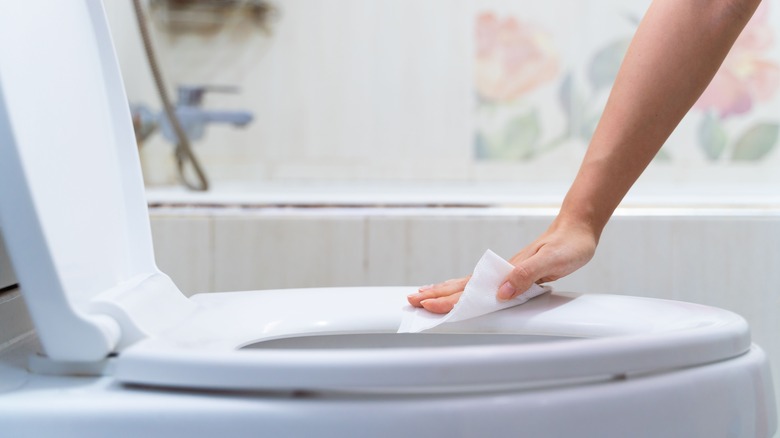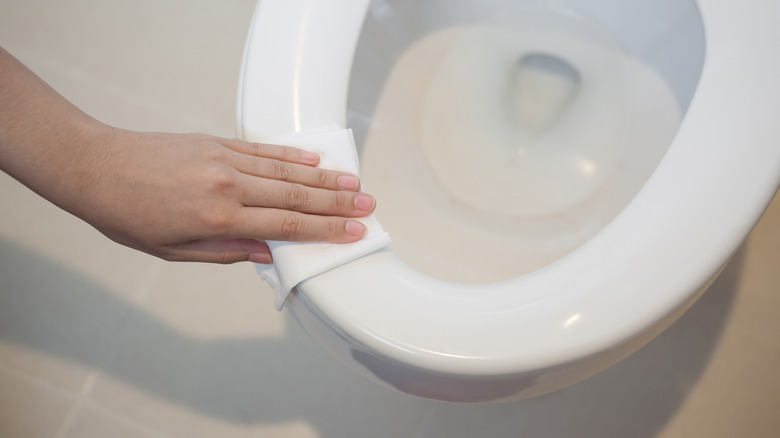The Hidden Downsides To Cleaning Plastic Toilet Seats With Soft Scrub
Removing bacteria and grime from a toilet seat is a rather simple task, but it can be surprisingly destructive when the wrong cleaning product is used. This is especially true for plastic toilet seats that are often less durable than other materials. Soft Scrub is among the cleaning products you should avoid using on plastic toilet seats. The abrasive calcium carbonate included in the formula may scratch this material, leaving you with an unsightly toilet seat that would need to be repaired.
Although the calcium carbonate pieces in Soft Scrub make the perfect exfoliator for scrubbing dirt and grime away from surfaces that are a bit more scratch-resistant, you should be cautious about using the product on a plastic toilet seat. Some customers have even shared first-hand experience of the damage caused by this product. It is best to save your Soft Scrub for surfaces that can handle its scrubbing power and turn to more gentle products, which is one of many tips on how to clean your toilet.
Soft Scrub can scratch plastic toilet seats
If you have been tempted to try any plastic toilet seat cleaning hacks that involve the use of Soft Scrub, the TikTok posted by user @anxietyscrubs might just convince you that this is not the wisest decision. As you can see in the video above, the content creator explained that the product scratched a plastic toilet seat in a previous apartment. Additionally, @anxietyscrubs warned against using steel wool pads on this surface. With this in mind, you may also want to avoid cleaning plastic toilet seats with harsh scrubbing brushes, scouring pads, or any other tools or solutions that are super abrasive.
It is important to note that the Soft Scrub website confirms the product can be used in a toilet bowl, but does not state that it can be safely used on a plastic toilet seat. This may explain why @anxietyscrubs accidentally damaged the surface with this product. While using Soft Scrub on a plastic toilet seat is a risk, there's no problem using it inside your toilet bowl. The cleaning solution can clean more durable surfaces without causing scratches thanks to the low hardness rating of calcium carbonate. This scrubbing ingredient is rated at level 3 on the Moh's Hardness Scale.
How to clean a plastic toilet seat safely
There is no special toilet cleaning trick you need to rely on to remove grime from a plastic toilet seat. The process is super simple. To clean this surface, start out by applying a mild, non-abrasive cleaning solution or a neutral soap all over. You can make the soap easier to apply by pouring it into a spray bottle and thinning it out with water. Spray the entire seat with the solution. Next, use a gentle cleaning cloth, paper towel, or sponge to wipe the cleaning solution away. It should have loosened up any grime to make it easier to remove. You may need to repeat this process to tackle particularly stubborn stains. Feel free to let the cleaning solution sit for a few minutes to allow it to really penetrate any grime that refuses to budge.
You can use this same cleaning solution to tackle your toilet's hinges and lid. Simply spray it onto these surfaces and wipe it away with a cloth or sponge. Do not forget that you can go in with Soft Scrub or your favorite toilet bowl cleaning solution when tackling your toilet bowl if needed. This may help you remove built up grime easier than a simple soap and water solution.

